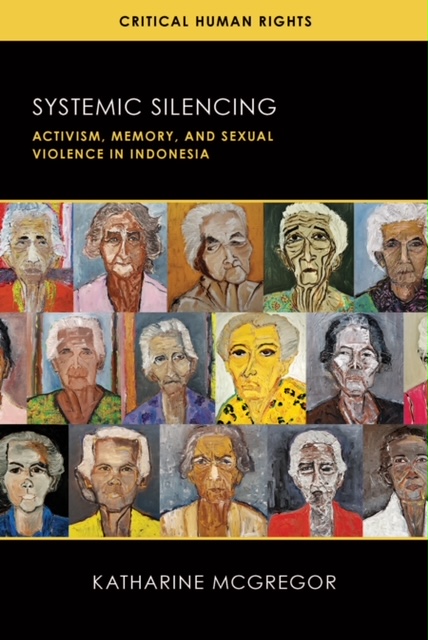The system of enforced prostitution by the Japanese military went unpunished and unexamined for decades after the Asia-Pacific War. International recognition only began in 1991 when Korean survivor Kim Hak-sun spoke out in graphic detail about her dark past. In Systemic Silencing: Activism, Memory, and Sexual Violence in Indonesia, University of Melbourne historian Kate McGregor tells the story of the transnational struggle for recognition and redress for and by the women of East and Southeast Asia. Focusing on the less studied case of Indonesia, she points out how the sexual abuse and exploitation of Indonesian woman began during the Dutch colonial era. She reveals how collaboration with the Japanese, sentiments of shame, and Cold War political and economic pressures favored the silencing of this past.
Language always matters. The words and labels we use influence our understanding of the past. The widespread use of the label “comfort women” does much to obfuscate or diminish the true brutality of what Kate McGregor prefers to describe as “the system.” “Comfort Women” is a translation of the Japanese term “ianfu”, or women who provide “comfort, solace, relaxation and consolation.” The term “comfort women” suggests that women voluntarily offered their services to Japanese men. In reality, most of the women who fell victim to this system were coerced, duped, and sometimes kidnapped. Subjected to beatings, rape and the constant threat of violence they lived in guarded, walled compounds often far removed from local support networks.
The exploitation of Indonesian women did not begin with the Japanese military occupation. During the era of the Dutch East Indies, the scarcity of European women in Indonesia led Dutch men, including soldiers, to take live-in partners or nyai. As global trade expanded during the nineteenth century, commodities and raw material found in the Dutch East Indies made the colony a pole of attraction for more single men and laborers creating a demand for prostitution. Japanese men who resided in the colony recruited women from the poorer regions of Japan to work in brothels called karayukisan. Kate McGregor notes that there were several hundred Japanese women working in karayukisan before the military occupation. In short, unequal relations and the sexual exploitation of women in Indonesia were well established long before the start of the Asia-Pacific War.
In 1992 Tuminah was the first Indonesian woman to speak out about her experiences in the system. A headstone with her photograph as a middle aged woman and a plaque, paid for by her supporters a decade after her death, can be found at her grave in Solo in central Java. The dedication on the headstone recognizes her pathbreaking role as former “comfort woman” who “broke the wall of silence” in the struggle for recognition by and for Indonesian women who were victims of enforced prostitution by the Japanese military. Tuminah, whose virginity was sold by her father to a Dutchman prior to the Japanese occupation and later forced into the system, did not fit neatly into the profile of the untainted Indonesian woman ravaged by the Japanese. As such, she was later eclipsed and replaced by a woman named Mardiyem whose story of victimization helped deflect charges that the “comfort women” were really only paid sex workers and little deserving of public sympathy. The examples of Tuminah and Mardiyem reveal how the need to elevate stories of victimization that resonate with the broadest possible audience often determine whose stories are remembered or forgotten.
Another factor that complicates the memory of the system of Indonesia is the history of Indonesian collaboration with the Japanese. The most prominent example is that of nationalist leader Sukarno. Although he later claimed that his intention was to instrumentalize the Japanese to advance the cause of Indonesian independence and to shield untainted Indonesian women, Sukarno assisted the Japanese by helping to recruit Indonesian women already in the sex trade for the new Japanese run system. Village chiefs, motivated out of fear or by the desire to preserve their status and privilege, also played an important role in recruiting local women.
The International Military Tribunal for the Far East, also known as the Tokyo Trial, prosecuted Japanese leaders for crimes committed during the war. While rape and “the abuducation of girls and women for enforced prostitution,” were regarded as punishable crimes they were not categorized as war crimes or crimes against humanity. Rape victims were not heard as witnesses and prositution was almost entirely absent from the deliberations. Kate McGregor surmises that the focus on crimes related to waging a war of aggression or the interest of the victors in crimes committed against Europeans may explain the lack of attention paid to the victimization of Asian women. Only the Dutch prosecuted the Japanese for the crime of enforced prostitution but even these trials focused primarily on cases involving European women. In the Netherlands, however, the memory of the abuse of Dutch women by the Japanese military was largely overshadowed by the memory of the German occupation.
The Japanese government did try to make amends for crimes committed during the Asia-Pacific War. However it did so through various treaties that were heavily influenced by the interests and Cold War imperatives of the United States. As the fight to contain the spread of communism became the new postwar American priority, Japan’s speedy recovery became paramount. Encouraging the Japanese to sign development assistance treaties with countries like Indonesia served the dual purpose of creating economic markets and partners for Japan while boosting the economies of other Asian countries against the threat of communism. Through the 1958 treaty signed with Indonesia, Japan paid $400 million in the form of products and services. Following the 1965 coup that brought Suharto to power, Japan became one of Indonesia’s leading sources of foreign aid and investment. This heavy dependency on Japanese economic support has and continues to complicate efforts to address memories of the Asia-Pacific War.
The struggle for recognition of historical cases of sexual violence in Indonesia and ongoing cases of sexual violence is far from complete. The other key contribution this activism has made is to draw attention to the experiences of women who were long marginalized historical subjects. In doing so, it has contributed to the project of democratizing Indonesian history and promoting a new questioning of what counts as history. Kate McGregor, Systemic Silencing: Activism, Memoryand Sexual Violence in Indonesia.
The struggle for recognition and redress by and for the women who were subjected to enforced prostitution during the Asia-Pacific War began earliest in South Korea and Japan. In the case of South Korea sensitivity to the victims of militarized sexual abuse was an outgrowth of the brutal treatment of women who participated in the pro-democracy movement. In both South Korea and Japan the rise of feminist movements and women’s studies programs contributed to an awareness of and concern about the mistreatment of women in the past. In Japan, the Japanese Bar Association, inspired by the example of West Germany’s efforts to confront the past, became a powerful force for change.
If Indonesia lagged behind Japan and South Korea in confronting the memory of the system, political repression and the stifling of civil society are partly to blame. Gerwani (1954-1965), or the Indonesia Women’s Movement, developed a significant following during the 1950s and early 1960s. Gerwani was active in denouncing the violence experienced by women both at home and at the hands of the military. However, when Suharto seized power in 1965 and launched a reign of terror on the left, Gerwani became one of his victims. The organization was dismantled and many of its members were arrested, tortured, sexually abused, sent to forced labor and even murdered. In their place, Suharto constructed a conservative new order that left little room for women outside the home and family.
It was the 1993 arrival in Indonesia of members of the Japan Federation of Bar Associations on a fact finding mission that provided an important stimulus to memory activism regarding the system in Indonesia. Charged with gathering evidence of wartime abuses, the visit inspired women like Mardiyem to speak out about their past. Indonesia’s minister of Social Affairs called on women to come forward and a grassroots justice organization called Indonesian Legal Aid began to collect evidence of wartime abuses. However, the limited resources of Indonesian Legal Aid, and the vast array of work they took on, made it impossible for them to seek legal recourse against the Japanese government.
In 1993 the Japanese government officially acknowledged the crime of enforced prostitution during the Asia-Pacific War in the form of a statement made by Chief Cabinet Secretary Yohei Kono. Under pressure from various activists, especially in Korea, the Asian Women Fund was created in 1995 to compensate survivors. To resolve the dilemma of the Japanese government’s refusal to make direct payments to victims, the Fund drew from two monetary sources. One source came from the government and another from private Japanese citizens. Only money from Japanese citizens could be paid to victims of the Japanese military. It was precisely the failure of the Asian Women’s Fund to pay victims directly together with the tendency to blame the victimization of Asian women on the war rather than the Japanese military, that caused many activists to reject it. In the end the Asian Women’s Fund did reach an agreement with the Indonesian government. However, the agreement was to build nursing homes. This further outraged many activists because few survivors ever benefited from this welfare support.
With the fall of the Suharto government in May 1998 and the liberalization of the media there was a brief period where activists could talk more openly about different periods of sexual violence. May 1998 was a period of extreme sexual violence targeting hundreds of ethnic Chinese women in Indonesia. To the present day, however, there have been no convictions of members of the military for involvement in this violence. Despite a greater degree of openness about sexual violence in Indonesia’s past, especially during the 1965 coup, the miltiary continues to enjoy a wide degree of impunity.*
*Header Photo: Indonesian Survivors at the 2000 Tribunal, Tokyo. Photograph by Kimura Kōichi. Home Page Photo: Dedication on the Headstone of Tuminah’s Renovated Grave, Solo. Photograph by Kate McGregor. I would like to thank Kate McGregor for sharing these photographs with me.

Kate McGregor
Kate McGregor is Professor in Southeast Asian History and Deputy Associate Dean International (Indonesia) Faculty of Arts at the University of Melbourne. She is the author of History in Uniform: Military Ideology and the Construction of Indonesia's Past (2007), Gender, Violence and Power in Indonesia (with Ana Dragojlovic and Hannah Loney, 2021) The Indonesian Genocide of 1965: Causes, Dynamics and Legacies (with Jess Melvin and Annie Pohlman, 2018), and Systemic Silencing: Activism, Memory, and Sexual Violence in Indonesia (2023)


